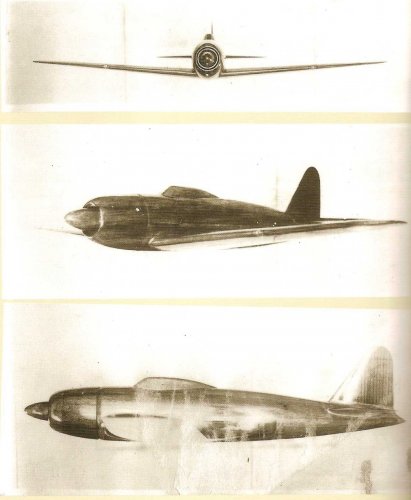lastdingo
Blogger http://defense-and-freedom.blogspot.de/
I assume the A7M Reppu is well-known among the readers of this forum. I've got a question about it and found no dedicated A7M thread, so here's one!
For starters: It was a prototype for a new Japanese carrier-borne fighter; didn't make it into production till the end of WW2. It was designed as a true successor to the A6M.
I'm aware that this fighter (would have) combined adequate protection, good armament, very good range and excellent (turn) agility.
Yet, there's one thing that irritates me.
It's the same as with the Ki-100 and several other Japanese fighters (and even the F6F Hellcat).
The top speed (sources generally agree on about 630 km/h) looks way too slow, and it's usually given for medium altitude (like about 6,000 m). Aircraft are slow at low altitude because of the higher drag (more dense atmosphere), but 630 km/h is ridiculously slow for 1945. New European propeller fighters of 1944/45 ranged at speeds between 700 and 780 km/h, and new versions of old models made between about 650 and 750 km/h.
A rule of thumb says that fighters weren't able compensate for a 80 km/h speed disadvantage. Agility still helped for defensive maneuvers, but such a speed disadvantage was simply unbearable for fighter pilots in WW2. They were prey for hit&run tactics in slow fighters.
630 km/h is like the Fw190's speed in 1942. It's unacceptably slower than a P-51D/H, P-47D/N, late Seafire, Bearcat and late Corsair.
Therefore my question (about A7M top speed and about similar cases, like Ki-100):
Does anybody have hints that could explain or falsify this top speed?
I know that somewhere deep in this forum someone already showed test flight reports (of WW2) that mentioned a higher Hellcat top speed than is usually given in sources. I hope someone could uncover something like this.
For those who expected some eye candy:
http://www.ijnafphotos.com/jbwa7m1.htm
or info:
http://www.aviastar.org/air/japan/mitsubishi_a7m.php
For starters: It was a prototype for a new Japanese carrier-borne fighter; didn't make it into production till the end of WW2. It was designed as a true successor to the A6M.
I'm aware that this fighter (would have) combined adequate protection, good armament, very good range and excellent (turn) agility.
Yet, there's one thing that irritates me.
It's the same as with the Ki-100 and several other Japanese fighters (and even the F6F Hellcat).
The top speed (sources generally agree on about 630 km/h) looks way too slow, and it's usually given for medium altitude (like about 6,000 m). Aircraft are slow at low altitude because of the higher drag (more dense atmosphere), but 630 km/h is ridiculously slow for 1945. New European propeller fighters of 1944/45 ranged at speeds between 700 and 780 km/h, and new versions of old models made between about 650 and 750 km/h.
A rule of thumb says that fighters weren't able compensate for a 80 km/h speed disadvantage. Agility still helped for defensive maneuvers, but such a speed disadvantage was simply unbearable for fighter pilots in WW2. They were prey for hit&run tactics in slow fighters.
630 km/h is like the Fw190's speed in 1942. It's unacceptably slower than a P-51D/H, P-47D/N, late Seafire, Bearcat and late Corsair.
Therefore my question (about A7M top speed and about similar cases, like Ki-100):
Does anybody have hints that could explain or falsify this top speed?
I know that somewhere deep in this forum someone already showed test flight reports (of WW2) that mentioned a higher Hellcat top speed than is usually given in sources. I hope someone could uncover something like this.
For those who expected some eye candy:
http://www.ijnafphotos.com/jbwa7m1.htm
or info:
http://www.aviastar.org/air/japan/mitsubishi_a7m.php






















